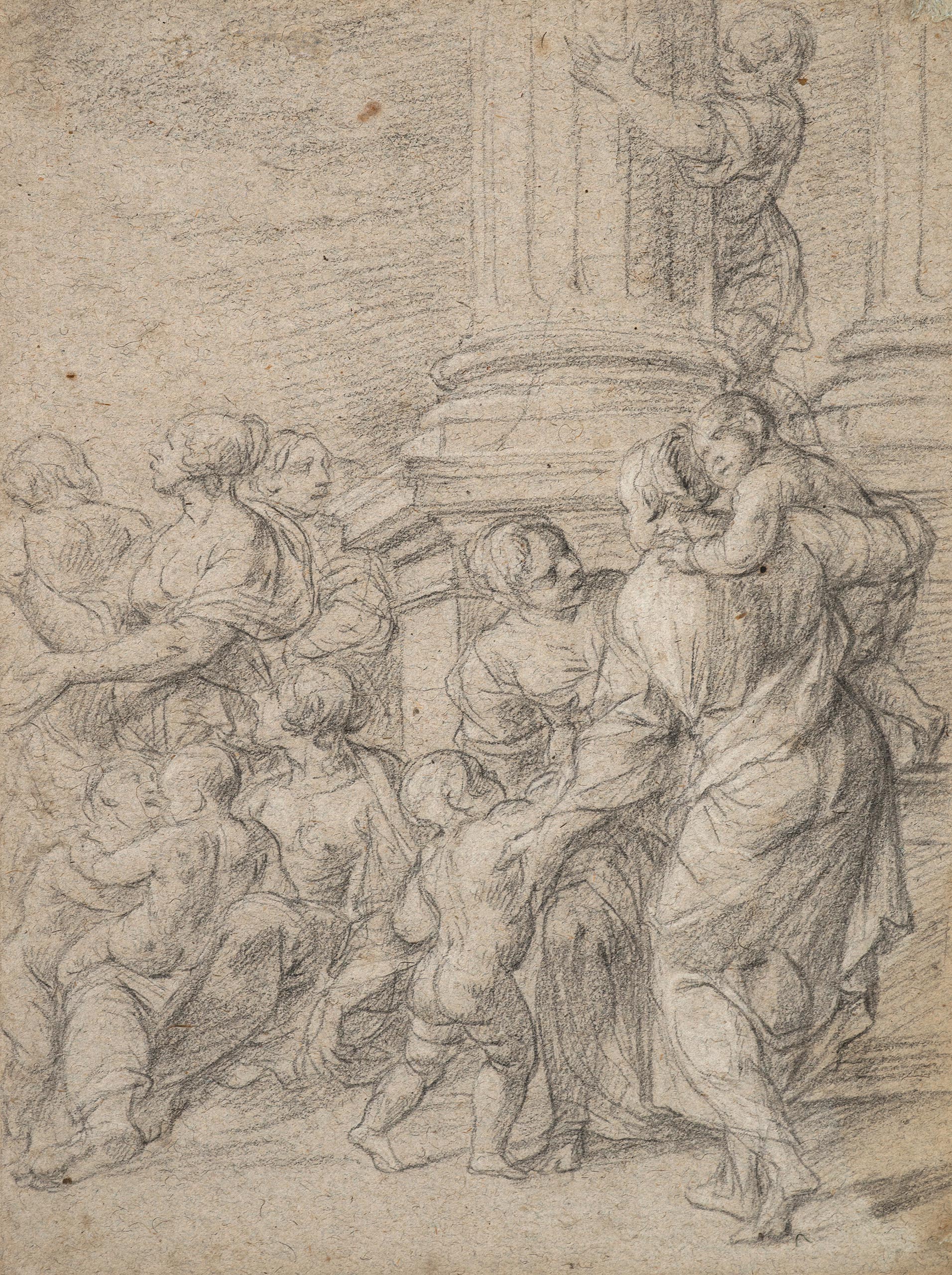
Busca
Antonio
Milan 1625 — 1686
Studies of Women and Children (recto);
Selene Appearing to Two Kneeling Draped Figures (verso)
Black and white chalk on grey paper.
On the verso, inscribed Diana. …. lower centre and numbered 766 lower right.
268 x 198 mm (10 9⁄16 x 7 13⁄16 in.)
Though he was respected as an artist and professor during his lifetime, Busca was quickly forgotten, not least because many of his works, mostly religious, were destroyed. His bibliography is fairly slim. The usual art historical sources for the art of Lombardy including Carlo Torre, Francesco Bartoli, Servilio Latuada1 and Luigi Malvezzi2, mention him regularly, but it was not until Giacinta Rossi published an article in 1959 that Busca’s most important works were finally studied3. A pupil of Carlo Francesco Nuovolone, Busca appears to have worked on several decorative projects in Milan and Turin under the direction of Ercole Procaccini. The most notable work from this period is The Erection of the Cross, painted for the Chapel of the Crucifixion in the church of San Marco, Milan, where Busca worked alongside Johan Christoph Storer, Guglielmo Caccia known as ’Il Moncalvo’ and Luigi Pellegrino Scaramuccia.
In 1664, Busca was commissioned to execute the fresco schemes for the San Siro chapel in the Certosa di Pavia Carthusian monastery; in 1669, he decorated the Arese chapel in San Vittore, Milan. That same year, he was chosen together with other artists, to organise the reopening of the Ambrosiana Academy of Painting (closed following the death of Federico Borromeo in 1631), where he was elected ’master of painting’, in other words, director. He was also commissioned to paint the decor for the entrance doors to the Academy. This institutional role shows that the reputation enjoyed by Busca at the time was at least equal to that of better-known artists such as Stefano Maria Legnani, Andrea Lanzani and Filippo Abbiati.
Busca’s drawings show the ease and style inherited from the Procaccinis and belong to a firm Lombard graphic tradition, particularly in their use of coloured paper. This sheet is not linked to any known painted work, but its proximity with other drawings by this artist leaves its authorship in little doubt. Worth mentioning are two sheets made in a very similar style belonging to the Academia Galleries in Venice: The Virgin and Child with Saint Dominic and Saint Peter Martyr (Inv. 737) and a scene with an unidentified subject depicting women and children that is very close to ours (Inv. 684). Both are executed on coloured paper and have an identical graphic style seen notably in the rounded physical types and slightly heavy drapery. Among the many sheets by Busca in the Ambrosiana, few of which are related to painted works, two deserve mention for comparison: Virgin and Child on Clouds (Inv. 6783) and Figures in a Wood (Fig. 1), both works where the mark-making is even more schematic than on ours. The physical type of the children – stocky with large heads – is quite characteristic. It should also be noted that most of Busca’s surviving sheets are figure studies showing fragments of compositions where the subject is difficult to identify.
- Carlo Torre, Il ritratto di Milano, Milan, 1714 (first edition 1674), p. 51, 130, 145, 160, 197, 204, 239, 255, 286, 365.); Francesco Bartoli, Notizia delle pitture, sculture, ed architetture (…) d’Italia, Venice, 1777, p. 137, 178, 184, 211, 215, 223, 227, 238; Servilio Latuada, Descrizione di Milano, Milan 1737, I, p. 91.
- Luigi Malvezzi, Le glorie dell’arte lombarda, Milan, 1882, p. 219, 221, 226, 238, 268, 277, 280.
- Giacinta Rossi, “Notizie su Antonio Busca”, Arte lombarda, 4.1959, 2, 314-322.

